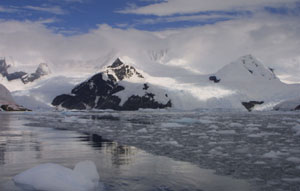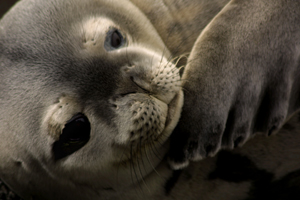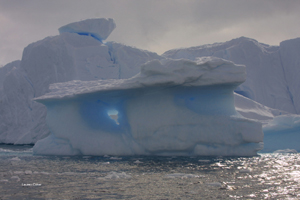12:35 p.m., Feb. 24, 2003--It’s said you haven’t been to Paris until you’ve taken a bateau-mouche down the River Seine. But what is the “must-see” when you trek to the least-visited continent on the face of the Earth?
For the 16 intrepid undergraduates on the University of Delaware’s Winter Session in Antarctica expedition, one of the peak travel moments was “staring in awe at your first iceberg, not white in color, as you expected, but so very blue. And incredibly massive, yet delicate in its detailed texture,” program participant Danielle Quigley, AS 2003, said.
 |
| Photo by April Effort |
Another “never-forget” moment was watching a 30-foot, white-bellied minke whale playfully bob and weave around the students’ small rubber raft. And, camping out on the ice pack one drizzly night, under the perpetual—but ever-changing—light of the Antarctica summer. Soon abandoning any efforts to sleep, the students sat wordlessly, transfixed by the thunderous roar of icebergs cracking and the sight of avalanches sliding into the sea.
However, the students enrolled in this intensive three-week photojournalism course were far more than tourists at one of the most pristine places on Earth. Instead, these undergrads were faced with the ambitious task of understanding the key historical, political, environmental and scientific issues of the region. And then documenting these issues, both in pictures and words, in a mobile digital publishing lab filled with $150,000 worth of high-tech equipment.
Collectively, the class took some 40,000 digital photographs. Students designed postcards and wrote feature-length magazine articles. Their faculty presented shipboard lectures—open to the vessel’s 80 other passengers—on topics ranging from the geopolitics of Antarctica to the ethics of photo manipulation. They packed a tremendous amount into their three-week expedition. Even a weeklong stopover in Argentina, originally designed as a time for rest, relaxation and the completion of research projects, was filled with educational outings, including a daytrip to Uruguay. About the only thing the student researchers didn’t do was sleep.
 |
| Photo by Bryan Townsend |
“I slept about four hours each night and the students probably slept even less,” photography instructor Jon Cox, said. He led the expedition along with Ralph Begleiter, UD’s Edward F. and Elizabeth Goodman Rosenberg Professor of Communication and Distinguished Journalist in Residence. Cox, a veteran of the University’s Study Abroad program both as a participant and now an instructor, said the Antarctica experience was unlike any other.
“It was beyond what I ever expected,” Cox said. “The light was so incredible that I personally took 4,000 images in 12 days. And the first time I saw an iceberg I stood there for the longest time, just gazing at it. I could not turn away.”
Like Cox, Begleiter is no stranger to travel, having visited some 91 countries and logged nearly 2 million miles as a foreign correspondent for CNN. Yet he also found Antarctica to be one of the most memorable places he has ever been. “There’s nothing on par with it anywhere,” Begleiter said. “It’s so untouched that the animals are not afraid. The whale swimming by our Zodiac raft seemed to have had no previous exposure to humans and so it had no fear of us.”
Upon their return to campus, UD’s Antarctica explorers were peppered with questions about the seventh continent’s notoriously harsh climate (which was actually warmer than Delaware this past January); their living conditions aboard a Russian research vessel; the foods they ate on board; and any scary moments they experienced.
 |
| Photo by Lauren Coker |
And, while it undoubtedly takes physical fortitude to endure a night camping out on the ice as a cold rain falls, or to transverse a narrow gangway from a ship to a rubber dinghy waiting far below, the young travelers agreed that the challenges they faced were more mental than physical.
They said they had to push aside worries and what-if about accidents and unforeseen circumstances. They had to work closely with each other—relative strangers at the onset—in an intense, 24/7 learning environment. They had to complete a tremendous number of projects and assignments in a very short time. Most importantly, they had to go outside their comfort zones in ways both large and small.
Quigley, a photojournalism major who plans to make a living expressing herself through her images, not her words, found the voice to join in debates about the geopolitics of the region. And, political science major Josh Galperin, AS 2004, gamely plunged into the world of digital photography, struggling to understand the implications of light, color, contrast and design.
“I really didn’t have a lot of experience with photography, let alone digital photography,” Galperin said. “But, I was proud of my efforts.”
On the surface, the student researchers studied three major content areas: photojournalism, wildlife photography and the geopolitics of Antarctica. Without a doubt, they learned a great deal about these subjects. For many, though, the most important thing gained on this once-in-lifetime trip was a better understanding of themselves.
“The trip changed my life. I know that sounds like a cliché, but it’s true,” Quigley said. “I tested myself and my limits… and you know what, I passed the test.”
For more information, visit [www.udel.edu/global/antarctica/].
Article by Margo McDonough, AS ‘86, ‘95M
|

